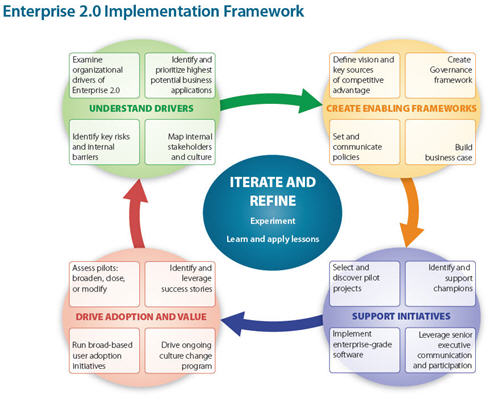There is no such thing as best practice for Enterprise 2.0
Dion Hinchcliffe has written a useful post titled Going beyond the hype: Identifying Enterprise 2.0 best practices, reviewing some of the work in the space, and with the intent of building a broader catalog of best practices.
There is already valuable information in the post, and I’m sure Dion’s research will yield useful insights. However I have to say upfront don’t believe in the concept of “best practice” with regard to almost any business activity, particularly with Enterprise 2.0. Managers may love the idea of finding and emulating “best practice”, but trying to do that is a setup to failure.
Just as our individuality as people is often hidden, we are gradually understanding that every organization is different.
For the last year in my future enterprise speeches I have been describing how there are two layers to organizations: the commoditized layer of standardized processes, and the differentiated layer of ad-hoc networks. Best practices can useful apply to standardized processes, but far less so in facilitating connection and collaboration across diverse organizations.
In his post Dion points to my Enterprise 2.0 Implementation Framework and says:
Ross Dawson has done a good job recently on the subject of Enterprise 2.0 methodologies with his Enterprise 2.0 implementation framework. As good as it is, it doesn’t emphasize what seems to be emerging as ground zero issues around risk, control, and trust with Enterprise 2.0. These are some of the key issues that will have to be managed most closely in any major social computing effort.
If these issues don’t appear to be emphasized enough, then I will need to redesign the framework. While Dion and I use slightly different language, anyone who has heard me speak or worked with me on implementing Enterprise 2.0 will know that I repeat ad nauseum that governance is the vital and critical enabler for Enterprise 2.0.
I also repeatedly emphasize the importance of the central element of the framework: Iterate, refine, experiment, and learn. The reason this is so critical is precisely that the solutions are different for every organization. It is impossible to import ‘best practices’ from elsewhere and expect them to work. The key competence is being able to try things in your own organization, see how they work, learn from them, and iterate to discover what works in one specific context.
There is no competitive advantage from using a guidebook of best practice. There is immense potential competitive advantage from going through the challenging and never-ending path of building a truly high-performance organization that fully taps the potential of its people.
I am sure that Dion’s work will prove to be very useful. But even labelling something “best practice” creates a mindset of replicating others’ processes that is likely to lead to failure in implementing Enterprise 2.0.
[UPDATE:] Dion has linked here from his post – he is clearly a genuine believer in the value of debate and discussion (and so absolutely qualifies for Enterprise 2.0 guru status :-) ).

